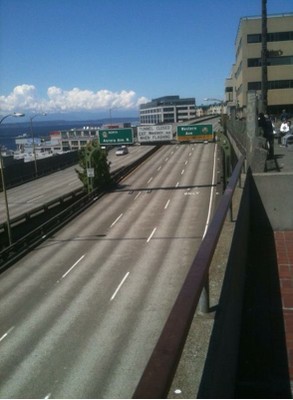 If the deep bore tunnel to replace the Alaskan Way Viaduct does get built it’s supposed to come with about $200 million in additional investment in transit infrastructure. Where does that number and notion come from? It comes from the big agreement signed by Governor Gregoire, and the now former mayor of Seattle, and the King County executive. Here’s what it said:
If the deep bore tunnel to replace the Alaskan Way Viaduct does get built it’s supposed to come with about $200 million in additional investment in transit infrastructure. Where does that number and notion come from? It comes from the big agreement signed by Governor Gregoire, and the now former mayor of Seattle, and the King County executive. Here’s what it said:
King County is responsible for additional Rapid Ride and peak express bus service to downtown Seattle. . . provide city street improvements related to improved bus operations. The total estimated cost for this work for King County is $190 million in capital and $15 million in annual operating expenses.
The whole tunnel deal is contingent on this agreement. But how is King County going to live up to this? The legislature has to pass legislation to give the county authority to collect a one percent Motor Vehicle Excise Tax. The legislature and governor have failed—twice—to get this done.
A movement has been born to urge the city council to condition their agreement on the state’s fulfillment of this promise. I haven’t the foggiest idea whether the money would reduce carbon emissions and by how much. Or whether the money would result in a drop in Vehicle Miles Traveled in the city. But everything I’ve ever read or said on the subject is premised on the fact that investment in transit instead of highways results in less auto dependence. Now all of that could be wrong, but I doubt it.
So what would it hurt if the city council conditioned it’s support of the tunnel on transit promised in the agreement? And what a great way for the city council to close the Sustainability Gap they opened up with the tunnel to begin with. What would it hurt? Hmmm. Maybe the tunnel agreement itself?
Photo taken by the author on an ordinary i Phone.








John Niles
I assume author Roger Valdez meant “But everything I’ve ever read or said on the subject is premised on the fact that investment in transit instead of highways results in less auto dependence.”To which one must add, this surely is a true-seeming relationship that has to be qualified by the specifics of the transit investment, for example, the quality of the resulting transit service and the routes it follows. For example, consider the current auto trips that now take people along the Alaskan Way Viaduct. If a portion of those trips are folks going every day from a West Seattle residence to a North Seattle job, then a fast bus or train from near their residences to near their work locations would undoubtedly pull some of them out of cars and onto transit. If the transit alternative provided service somewhere else, then car dependence for this subset of trip takers would continue unabated.Of course there are very many subsets, and it’s the sum of all the origins and destinations and trips by cars that use a segment of highway like Alaskan Way Viaduct that a highway-segment-replacing transit investment needs to serve in order to be a car-dependency reducer. A short segment of transit along the route of the relatively short Viaduct would cover in linear geographic terms just a small portion of the journey taken by tens of thousands of Viaduct users coming from a spread of origins and going to a spread of destinations. Lots of long transit routes and service would be needed to seriously reduce the automobile dependency of today’s Viaduct users. Think of Viaduct trips as lengths of spaghetti that converge on the Seattle waterfront in the middle part of their length, but that splay out in many directions to the north and south of it. Some such transit already exists along these spaghetti lines, such as Metro routes 54 and 55 interlined with Route 5, using the southern portion of the Viaduct. These routes to some degree reduce car dependency already.
DanDePhoenix
business insurance prices tqogys car insurance qoutes dkj life insurance =-]]]